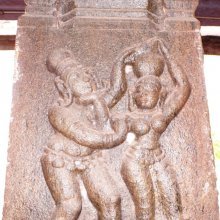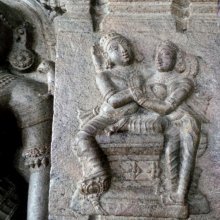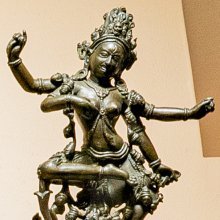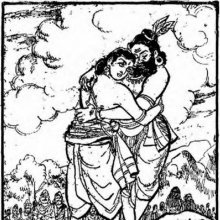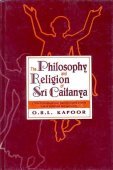Love: 3 definitions
Introduction:
Love means something in Hinduism, Sanskrit, Hindi. If you want to know the exact meaning, history, etymology or English translation of this term then check out the descriptions on this page. Add your comment or reference to a book if you want to contribute to this summary article.
Images (photo gallery)
(+17 more images available)
In Hinduism
Natyashastra (theatrics and dramaturgy)
Source: Shodhganga: Elements of Art and Architecture in the Trtiyakhanda of the Visnudharmottarapurana (natya)1) Love is denoted by the Sanskrit word Śṛṅgāra while the Love Gait is denoted by Śṛṅgāriṇī, which represents one of the various Gatis (“way of walking”) (in Indian Dramas), according to the Viṣṇudharmottarapurāṇa, an ancient Sanskrit text which (being encyclopedic in nature) deals with a variety of cultural topics such as arts, architecture, music, grammar and astronomy.—A person in elegant and stylish dress up walks in rhythmic footsteps with particular movements of arms along with the legs. One looks very graceful in it and it is generally adopted at the time of meeting with the beloved. That is why this type of gait is related to śṛṅgāra i.e., love. Moreover, this type of gait is seen in the walking of Dūtī i.e., female messenger.
2) Walking in Love is also associated with Sthira-gati: another one of the various Gatis (“way of walking”).—Sthira-gati denotes the steady movements. To show walking in fever, hunger, disease, tiredness due to penance, dissimulation, excitement, love and sorrow or ease, slow gait should be adopted by the artist. The lover who goes to meet his or her secret lover adopts the sthiragati. In darkness or if a deformed creature is visible or if a person walks a long way, the gait of a person becomes automatically slow down.
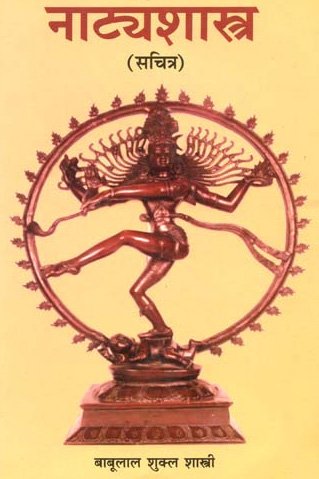
Natyashastra (नाट्यशास्त्र, nāṭyaśāstra) refers to both the ancient Indian tradition (shastra) of performing arts, (natya—theatrics, drama, dance, music), as well as the name of a Sanskrit work dealing with these subjects. It also teaches the rules for composing Dramatic plays (nataka), construction and performance of Theater, and Poetic works (kavya).
Languages of India and abroad
Hindi dictionary
Source: DDSA: A practical Hindi-English dictionaryLove in Hindi refers in English to:—(nm) a very small division of time; whit, particle; see [lau; ~lina] absorbed, engrossed (as in thought)..—love (लव) is alternatively transliterated as Lava.
...
Kannada-English dictionary
Source: Alar: Kannada-English corpusLōve (ಲೋವೆ):—
1) [noun] that part of the slant-roof of a building, that is projected beyond the outer wall.
2) [noun] the frame-work of a sloping roof.
Kannada is a Dravidian language (as opposed to the Indo-European language family) mainly spoken in the southwestern region of India.
See also (Relevant definitions)
Starts with: Love apple, Love bean, Love grass, Love pea, Love thorn, Love vine, Love-in-a-mist, Love-in-a-puff, Love-in-idleness, Love-ina-mist, Love-lies-bleeding, Love-making, Lovegrass, Lover, Lover-in-a-mist.
Ends with: Addalove, Burning love, Clove, Common foxglove, Cumculove, Foxglove, Grecian foxglove, Green love, Large yellow foxglove, Love-making, Mupombohlove, Slenderleaf false foxglove, Surlove, Wild foxglove, Yellow foxglove.
Full-text (+3944): Rati, Shringara, Kama, Prema, Anuraga, Sambhoga, Manmatha, Manasija, Priyata, Priti, Ananga, Sneha, Vatsalya, Anurati, Madana, Bhavaja, Smara, Kamarta, Muhira, Pancabana.
Relevant text
Search found 443 books and stories containing Love, Lōve; (plurals include: Loves, Lōves). You can also click to the full overview containing English textual excerpts. Below are direct links for the most relevant articles:
A Happy Married Life (by Venerable K. Sri Dhammananda)
Love < [Part 1 - The Nature Of Love And Pleasure]
Sex < [Part 1 - The Nature Of Love And Pleasure]
Tiruvaymoli (Thiruvaimozhi): English translation (by S. Satyamurthi Ayyangar)
Pasuram 9.10.6 < [Section 10 - Tenth Tiruvaymoli (Malai nanni)]
Introduction to Section 9.6 < [Section 6 - Sixth Tiruvaymoli (Elliyum kalaiyum)]
Pasuram 6.5.10 < [Section 5 - Fifth Tiruvaymoli (Tuval il ma mani matam)]
Garga Samhita (English) (by Danavir Goswami)
Verse 5.17.3 < [Chapter 17 - The Gopis Describe Their Remembrance of Sri Krsna]
Verse 5.17.8 < [Chapter 17 - The Gopis Describe Their Remembrance of Sri Krsna]
Verse 6.16.32 < [Chapter 16 - Seeing Śrī Rādhā’s Form]
Complete works of Swami Abhedananda (by Swami Prajnanananda)
Chapter 6 - Immortality and the Self < [Discourse 2 - Self-Knowledge]
Chapter 3 - Manifestation of Divine Love < [Discourse 7 - Human Affection and Divine Love]
Chapter 1 - Human Affection and Divine Love < [Discourse 7 - Human Affection and Divine Love]
Moulana Rumi’s Religion of Love < [March 1946]
On Vikram Seth’s ‘The Golden Gate’ < [October – December, 1995]
I Thus Question The Universal Mother < [January – March, 2000]
Parables of Rama (by Swami Rama Tirtha)
Story 60 - Why things are dear < [Chapter IX - Love]
Story 237 - The importance of honest and truthful work in life. < [Chapter XLVI - Success]
Story 47 - True Imitation < [Chapter VI - Ignorance]
Related products
(+21 more products available)
